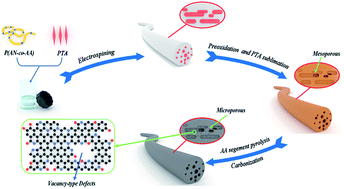Copolymer derived micro/meso-porous carbon nanofibers with vacancy-type defects for high-performance supercapacitors†
Abstract
Carbon nanofibers (CNFs) have been good candidates for electrode materials in supercapacitors (SPCs). It is desirable but still challenging to explore CNFs with both multiscale porous structures and high heteroatom doping. Herein, hierarchically porous CNFs (HPCNFs) are prepared with the use of poly(acrylonitrile-co-acrylic acid) (P(AN-co-AA)) and terephthalic acid (PTA). The degradation of the AA segments induces vacancy-type defects, which result in the formation of micropores inside the CNFs. In addition, the defects promote increased redox activity by increasing the N-P content. Moreover, PTA sublimation creates mesopores inside the HPCNFs, which can largely reduce ion transport resistance in the HPCNFs. The specific capacitance and area normalized capacitance (CA) of HPCNFs can reach as high as 327 F g−1 and 80.5 μF cm−2, respectively. Additionally, high capacitance retention and excellent cycling stability can be achieved. The HPCNFs with vacancy-type defects are promising for developing high-performance electrode materials for SPCs.



 Please wait while we load your content...
Please wait while we load your content...